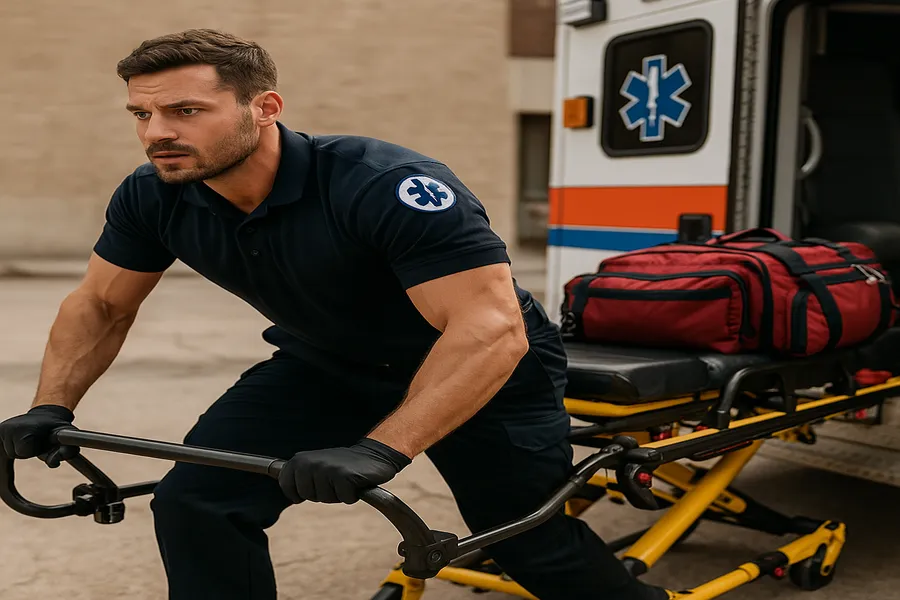Key Takeaways
- EMS professionals face unique physical demands, making targeted fitness essential for injury prevention and job performance.
- Tactical fitness routines combining strength, mobility, and cardiovascular training support long-term health and operational readiness.
- Department-supported wellness programs and shift-adapted workouts significantly improve crew resilience and reduce downtime.
When Readiness Depends on Resilience
EMS professionals face constant physical demands that go far beyond basic job expectations. Lifting, running, kneeling, and carrying patients in stressful environments requires both strength and stamina. Without targeted fitness, providers risk injuries that can end careers prematurely. Research continues to confirm that staying in shape directly improves performance on the job. A strategic, functional approach to fitness helps EMS professionals thrive both mentally and physically.
Understanding the Unique Fitness Demands of EMS Work
Why EMS Isn’t a Desk Job
EMS shifts often last 12 to 24 hours, filled with bursts of intense physical activity. Crews might carry heavy patients down stairs, crawl into crushed vehicles, or perform CPR for extended periods. Each task demands quick, powerful movements with little room for error. These unpredictable physical demands separate EMS from typical jobs. Staying fit becomes a core necessity—not a luxury—for safe, effective response.
Common Injuries and Health Risks in EMS Roles
The most frequent injuries among EMS professionals involve the back, shoulders, and knees. Poor body mechanics during lifting or patient transfers often contribute to these injuries. Long hours and chronic stress increase risks of cardiovascular conditions, making regular cardiovascular life support training critical for EMS professionals. Without consistent movement and strength work, musculoskeletal imbalances worsen over time. These health risks can limit job performance and career longevity.
Foundations of Tactical Fitness for EMS Professionals

What Makes EMS Fitness Different from Civilian Gym Goals
Most gym routines focus on aesthetics, but EMS professionals require function-first training. This means building strength and endurance that translate directly to job tasks. For example, lifting a stretcher during paramedic training builds core and grip strength essential for real-life emergency scenarios. EMS fitness also emphasizes movement under stress, mimicking real emergency scenarios. By training this way, responders improve their real-world readiness and reduce injury risks.
Essential Physical Domains for EMS
A balanced EMS fitness program targets three key areas: strength, cardiovascular endurance, and mobility. Strength ensures safe lifting, whether it’s gear, patients, or partners. Cardiovascular endurance supports long calls and quick recovery during repeated exertion. Mobility keeps joints healthy and movement fluid, reducing strain on the spine and limbs. Neglecting any one area can compromise performance in critical moments.
Building the Ideal EMS Workout Program
Weekly Split That Matches Shift Realities
EMS schedules often vary, so fitness programs must offer flexibility and consistency. A well-designed weekly plan includes three strength-focused days, two conditioning days, and time for recovery. Crews working 24-hour shifts can rotate training days to match low call volume windows. The goal is progress, not perfection—doing something beats doing nothing. Programs that adapt to shift life increase long-term success.
Sample Functional Fitness Routine
Start with total-body strength moves like trap-bar deadlifts, push-ups, and lunges. Add interval training—short bursts of effort with brief rests—for high-intensity conditioning. Mobility and core work such as bird dogs, planks, and hip stretches enhance control and joint health. On lighter days, ruck walks and yoga promote active recovery without overloading the body. This balance supports consistent fitness while reducing burnout.
Injury Prevention Strategies That Actually Work
Top Injury Triggers in EMS and How to Counter Them
Back strain often results from poor lifting technique during stretcher operations or stair carries. Shoulder injuries stem from reaching overhead in cramped spaces like ambulances. Long kneeling sessions during CPR can strain knees and ankles. These injuries usually occur from repetition, poor preparation, or fatigue. A CDC study shows that overexertion accounts for a significant portion of EMS injuries annually.
Movement Corrections and Prehab Routines
Simple, consistent exercises can dramatically reduce injury risk for EMS providers. Bird dogs activate the core, while glute bridges support low-back stability. Side planks strengthen obliques—crucial for rotational control during lifting. Foam rolling and hip openers improve flexibility and help restore balance after calls. Done regularly, these routines offer long-term protection against repetitive stress injuries.
Adapting Fitness to EMS Life: On-Shift and Off-Duty Approaches
Micro-Workouts and Station-Based Training Ideas
Short, targeted workouts between calls keep fitness on track without draining energy reserves. Quick circuits with air squats, resistance band pulls, and glute bridges can be completed in five minutes. Ambulance steps or cot handles double as training equipment when space is limited. These mini-sessions also relieve stress and improve alertness. With consistency, micro-workouts build up real strength over time.
Long-Term Progress Tracking Without a Gym Membership
Fitness progress doesn’t require a gym or expensive equipment. Grip strength, stair-climb times, and pack carries serve as practical benchmarks. Mobile apps track workouts and recovery, offering reminders and accountability. Some crews use shared whiteboards at the station to log progress. Over time, these small steps build habits that promote durability and job satisfaction.
Department-Level Strategies to Promote Fitness
Embedding Fitness into EMS Culture and Policy
Agency support plays a major role in encouraging crew wellness. Leadership can carve out time for movement without reducing readiness. Daily 20-minute windows post-rig check or mid-shift offer realistic consistency. Departments that invest in wellness show lower injury rates and higher morale. Peer support and culture shifts make fitness a shared mission, not a solo struggle.
Leveraging National Standards and Certification Programs
Adopting fitness protocols from trusted organizations ensures safety and standardization. Programs like NFPA 1583, NAEMT/ACE guidelines, and pediatric life support certification ensure that readiness covers all age groups in emergency care. Peer Fitness Trainer certifications help create in-house coaches who understand EMS demands. These standards also help justify wellness investments with measurable outcomes. Departments that follow best practices see stronger, more resilient teams.
FAQ: EMS Fitness and Injury Prevention
What kind of workout schedule works best for 24-hour shift crews?
Split your sessions across your on- and off-days, and keep intensity moderate after overnight calls.
How can I train safely after a back or shoulder injury?
Focus on mobility and core stability first, then rebuild strength gradually under professional guidance.
Do I need expensive equipment to stay in shape for EMS?
No. Bodyweight, resistance bands, and tools from BLS for healthcare providers training can deliver great results on a budget.
What fitness benchmarks should I aim for as a paramedic?
Aim for consistent strength in carries, solid core control, and steady recovery after moderate exertion.
3 Practical Tips for Staying Fit as an EMS Professional
- Use Your Rig as a Gym: Perform step-ups on the bumper, rows with gear, or squats in the bay.
- Set Two Weekly Non-Negotiable Sessions: Treat them like high-priority calls—never miss them.
- Pair Movement With Recovery: Foam roll during downtime, and stretch after your post-call reports.
What Fitness Means for the Future of EMS
As the demands on EMS professionals continue to grow, physical readiness remains a key pillar of success. Crews who prioritize movement, strength, and mobility are more resilient under pressure. A sustainable fitness habit not only prevents injuries but also boosts confidence and performance. By treating fitness as a vital skill, EMS providers can extend their careers while improving outcomes. A recent study found over 88% of paramedics have at least one cardiovascular risk factor, underscoring the urgent need for change.

Jeromy VanderMeulen is a seasoned fire service leader with over two decades of experience in emergency response, training, and public safety management. He currently serves as Battalion Chief at the Lehigh Acres Fire Control & Rescue District and is CEO of the Ricky Rescue Training Academy, a premier provider of online and blended EMT and firefighter certification programs in Florida.
Jeromy holds multiple degrees from Edison State College and the Community College of the Air Force, and is pursuing his MBA at Barry University. He maintains top-tier certifications, including Fire Officer IV, Fire Instructor III, and Fire Inspector II, and has served as a subject matter expert for a court case. He is a member or the Florida Fire Chiefs Association.
Jeromy also contributes to state-level fire safety regulation and serves on several hiring and promotional boards.

